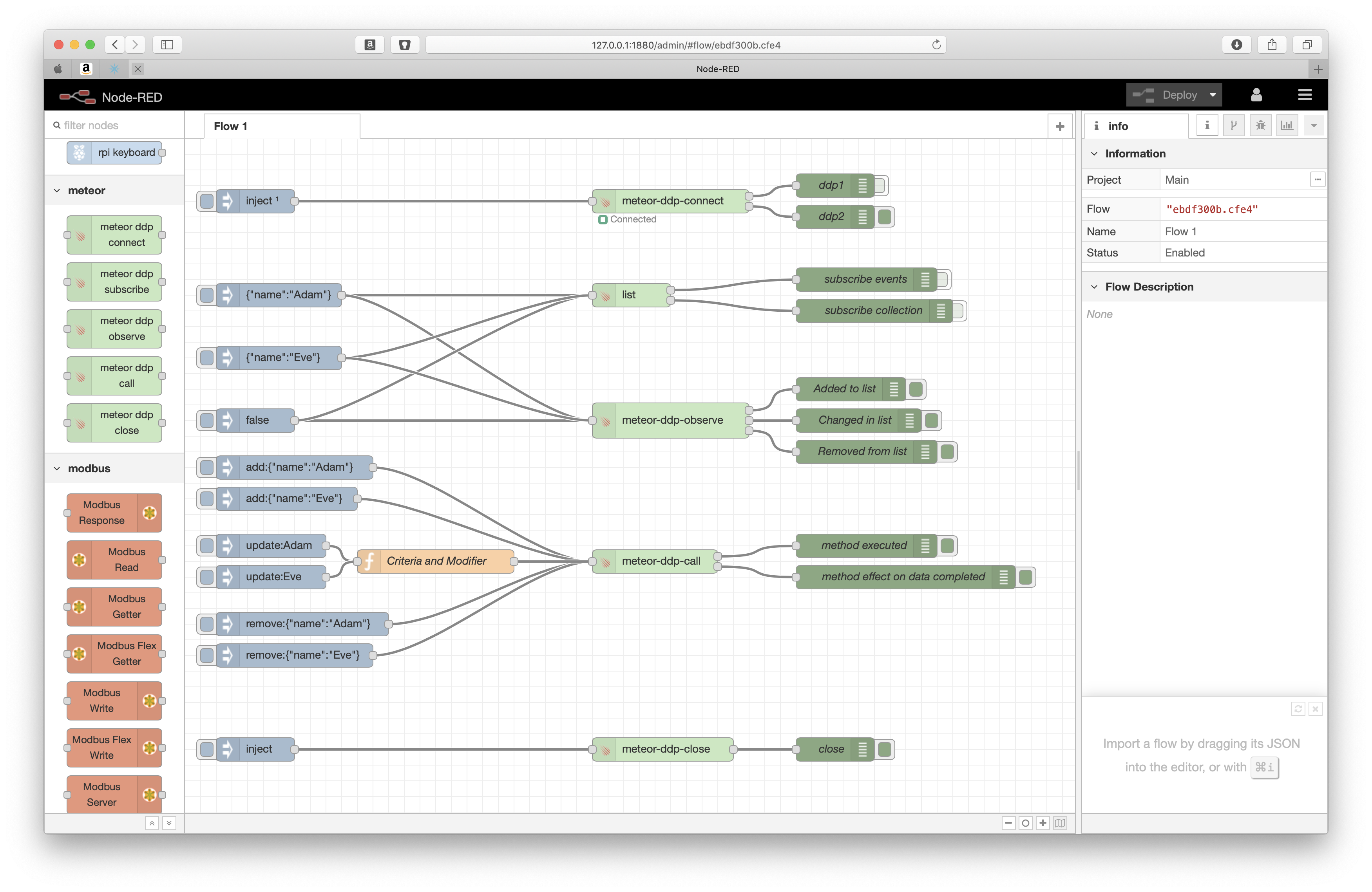README
NODE-RED DDP CLIENT
A suite of Node-Red nodes for communicate with MeteorJS DDP servers.
MeteorJS is a great Javascript framework, it's reactivity model is very interesting for IoT applications, but it can't run on edge devices like Raspberry PI with no tricky compilations.
Furthermore NODE-RED runs on Raspberry PI very well, and can be used not only on these devices but in the cloud too or on desktop PC. So if you want to connect a NODE-RED flow to a MeteorJS application re-using your API with Publish and Methods you are in the right place.
Another reason we at Techmakers developed this nodes is we want to connect to our MeteorJS developed applications with some technologies were the DDP protocol implememtation is difficult and time conuming, so we use NODE-RED as a "broker" from these tecnologies to the MeteorJS applications we distribute.
This work is a NODE-RED full implmementation of the DDP Client NodeJS package.
You can connect to one ore more MeteorJS applications, subscribe to the Meteor.publish and call the Meteor.methods from your NODE-RED flow.
Using the SESSION parameter in every node you can attach any subscribe, observe and call node to the right MeteorJS connection.
MeteorJS connections are stored in the NODE-RED global context so you can attach to the same MeteorJS connection from different NODE-RED flows.
Installing the NODE-RED nodes
This is a standard NODE-RED contribution, the name is: node-red-contrib-meteor-ddp so the usual
npm install node-red-contrib-meteor-ddp
will do the job. Don't forget to cd in the .node-red directory before lounching the npm install command.
Example flow
This picture shows how the example flow should appear on your NODE-RED interface.

Example Meteor application
- download if needed MeteorJS
- enter a desired directory
- create a Meteor Application with the command
meteor create myexampleand enter the directory withcd myexample - edit the file in myexample/server/main.js to obtain something like that
import { Meteor } from 'meteor/meteor';
var list = new Mongo.Collection("list") ;
Meteor.publish("list",function(params){
console.log("Params",params) ;
return list.find(params) ;
})
Meteor.methods({"add":function(params){
return list.insert(params) ;
}});
Meteor.methods({"update":function(params){
return list.update(params.criteria,params.modifier,{multi:true}) ;
}});
Meteor.methods({"remove":function(params){
return list.remove(params) ;
}});
Meteor.startup(() => {
// code to run on server at startup
list.insert({
name:'Ciao',
addedOn: new Date()
})
});
- now you can run the Meteor application with command
meteorand test the example flow clicking on the left-side injections nodes.
How to use example flow
We suggest some readings before start to play with this about the Meteor Publish and Subscribe concepts
- Be sure you have the Meteor Example Application up and running on the same machine you are running node-red, otherwise, update the
meteor-ddp-connectnode to attach to a different server - Import the example flow in your NODE-RED application
- Deploy the imported flow
- The flow automatically connects to the Meteor Example Application
- Subscribe and observe all documents in the
listcollection with name equals to "Adam" by clicking on the{"name":"Adam"}node. - Add a document to the collection clicking on the
add:{"name":"Adam"}node. - If everything is ok you should see on the right debug pane messages coming from the subscribe
listandmeteor-ddp-observenodes. - You can play switching from Adam to Eve and see what appens if you add a document in the
listcollection with the subscribe and observe. - You can also try to modifiy documents in the meteor database using MongoDB commands to insert, update, remove documents and receive events on the NODE-RED flow thanks the Meteor reactivity model.
Some words about security
MeteorJS security is usually implemented server side by limiting the access to datasets in the Meteor.publish and specifying the rules about writing in the database collection via the allow and deny collection methods: https://docs.meteor.com/api/collections.html#Mongo-Collection-allow.
These rules are based on checking the Meteor.userId() before publishing documents to the subscribing clients.
You can use the meteor-ddp-call node to call the "login" DDP method to have a valid Meteor.userId() on server side to check against methods and subscribes calls from the clients. Passing the credentials in the msg.payload object is possible.